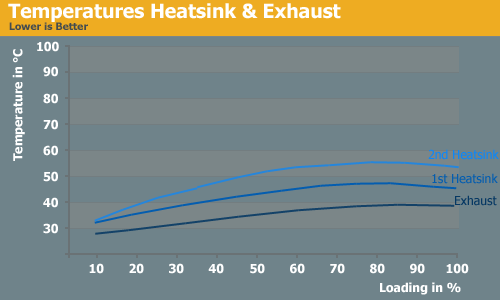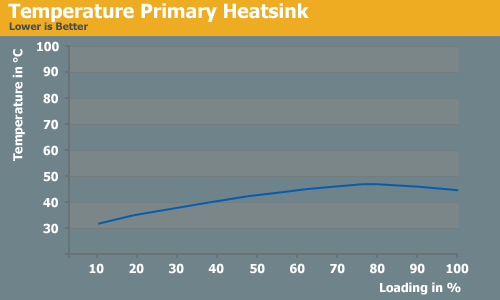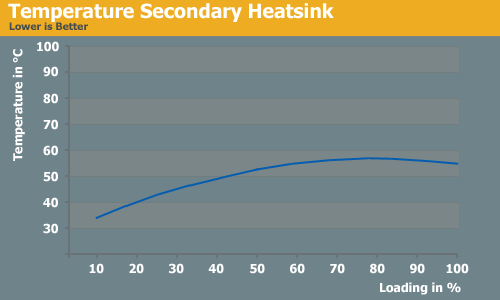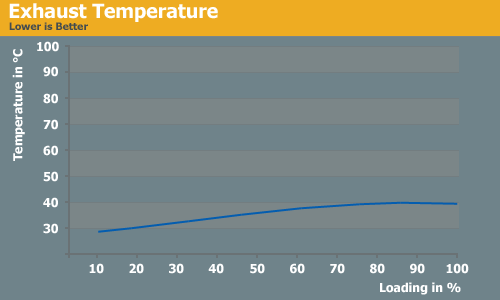PC Power & Cooling Silencer 750 Quad CF-Edition
by Christoph Katzer on July 18, 2007 1:00 AM EST- Posted in
- Cases/Cooling/PSUs
Temperatures (Ambient constant 25°C)
With an ambient temperature of 25°C we have added a new test to our regimen. With the additional results we hope users will be better able to form an opinion about the performance of the test power supplies. Speaking of additions, we have also added a new graph which shows the two heatsinks and the exhaust temperature together. Hopefully, we are done with making any more additions, as adding any more graphs at this point will likely do more harm than good in terms of conveying information without overwhelming anyone.




These results at 25°C are clearly lower than at higher temperatures. The second heatsink which is the hottest is just getting up to 56°C and decreases together with the other temperatures at 80% load. This is caused by the fan which runs at over 2400 RPM at that point. At the highest loads it is running at up to 3800 RPM and therefore the curves all start decreasing. More fresh air is coming through the power supply and therefore the components are better cooled.
Unlike the OP650 from Silverstone we see that the two heatsinks in the Silencer have a similar temperature. At most they have just 10°C difference, which is most likely the result of the two heatsinks being in relatively close proximity to each other. Not only that but they also don't get as hot as in the OP650.
With an ambient temperature of 25°C we have added a new test to our regimen. With the additional results we hope users will be better able to form an opinion about the performance of the test power supplies. Speaking of additions, we have also added a new graph which shows the two heatsinks and the exhaust temperature together. Hopefully, we are done with making any more additions, as adding any more graphs at this point will likely do more harm than good in terms of conveying information without overwhelming anyone.




These results at 25°C are clearly lower than at higher temperatures. The second heatsink which is the hottest is just getting up to 56°C and decreases together with the other temperatures at 80% load. This is caused by the fan which runs at over 2400 RPM at that point. At the highest loads it is running at up to 3800 RPM and therefore the curves all start decreasing. More fresh air is coming through the power supply and therefore the components are better cooled.
Unlike the OP650 from Silverstone we see that the two heatsinks in the Silencer have a similar temperature. At most they have just 10°C difference, which is most likely the result of the two heatsinks being in relatively close proximity to each other. Not only that but they also don't get as hot as in the OP650.










31 Comments
View All Comments
Belldandy - Wednesday, July 18, 2007 - link
Was the efficiency higher at constant room temperature @ 25? I'm just curious because in most well cooled cases, for example my Antec P180, the ambient temperature around the power supply never goes up, no matter how high the load.Perhaps the methodology should also test the max 12V current load that many new power supplies now advertise. Testing upto 50A when it's advertised to do 60A maybe the reason why the DC12V don't drop by all that much. Granted there are other reviews that have also found the Silencer's voltages to be very stable, interestingly the 5V line was more stable and never fell below 4.9V
Great job on the noise and temperature testing, it among the best of any reviews on the web. I have decided toget the Silencer after your review, and given I don't envision needing more than 600Watts, the efficiency numbers are very solid.
LoneWolf15 - Friday, July 20, 2007 - link
You want to measure power supply exhaust temperature, not ambient case temperature.The confined insides of a power supply will be quite a bit warmer than the ambient temperature of your case, even in a well-cooled case. It is not unusual to reach temperatures of 40C and higher in a number of situations.
Googer - Wednesday, July 18, 2007 - link
Perhaps, you should consider adding a 24 hour full load stability test to your psu testing procedures?If such testing is done I would recommend it be done in an area where fire cannot spread like a Concrete room/box or metal building and where full fire suppression capabilities are automatically dispensed.
dare2savefreedom - Wednesday, July 18, 2007 - link
WTF?anandy stop playing around...
Where's the 24 hour 3d geforce 8800gtx sli test?
Where's the triple 8800gtx sli test?
Where the audible sound test -> run a 8800gtx with a intensive 3d game and report whether
there is a high freq whine noise - I get that with a ultraX 600watt.
crimson117 - Wednesday, July 18, 2007 - link
AT Editors,You often in your PSU reviews mention the importance of hitting the proper spot on the efficiency/wattage curve to get the best performance from your power supply.
Now that you have your new PSU testing gear, can you provide a short article on the actual power needs for a few common systems setups?
Such as
- a budget X2 3x00+/4x00+ rig with a low/midrange GPU
- a midrange computer with a low/midrange end C2D and a 8800 GTS
- a high end computer with a OC'd C2D and a 8800 GTX (and also in SLI)
I would find this quite useful, and it would be very real-world information to provide to your readers.
Thanks!
LoneWolf15 - Wednesday, July 18, 2007 - link
This method is far from new. Prior to ATX 2.0, there were plenty of single 12v rail power supplies. I have two Antec 4U cases at home with single-rail 36A EPS power supplies, prior to that I've had several single 12v-rail Enermax ATX 1.x units.
I believe the possible danger mentioned in the article is overstated, and that Intel was conservative in their specifications, which are now aging fast. Done right, there is nothing to worry about, and vendors willing to put high-amp single rails in their power supplies are usually the few who take quality control seriously.
ATWindsor - Wednesday, July 18, 2007 - link
Yes, the danger-part is overrated, and having several rails is a big hassle (if you buy a PSU of the proper size for your usage), I'll take a single rail any day. Besides a lot of the "4 rail" PSUs in reality only have a single rail anyway, like for instance seasonic.AtW
Brunnis - Wednesday, July 18, 2007 - link
So, when will we get an article that discusses the actual need for power supplies like this? Why not put together a few different systems and measure the power consumption to see what is actually needed. My guess is that not even 1% of the computerized population own a computer that needs a 750W PSU (or comes close to needing it).People seem to think that 600-1000W PSUs are needed whenever a gaming machine is built, when even a decent 400W PSU would provide power to spare.
LoneWolf15 - Wednesday, July 18, 2007 - link
Problem is, that a gaming machine assumes at least one high-end video card in many cases (for the purposes of high-end, I'll assume a minimum Geforce 8800GTS). If you add one high-end graphics card, a moderate processor, and two hard disks (I rarely know a geek that has just one), a sound card, and a performance mainboard, you're getting up there, and most people want room for expansion. 400w in this day and age is very reachable, and when you consider that nVidia specs power requirements as a minimum of 450w with 30 amps on the 12v rail for the Geforce 8800GTX, consumption can be higher than you think (figures taken from Anandtech, http://www.anandtech.com/video/showdoc.aspx?i=2870...">link here).Amperage is actually more important in this case. When was the last time you saw a 400w PSU deliver that kind of amperage? You'd need to use two rails, and then still provide power from both of those rails to your remaining components. Of course, this is assuming a gaming system, a quality 400w PSU would be enough for almost any non-gamer's needs.
I'm not saying that everyone needs a 1kW power supply (I'm running a 550 myself). But I've seen plenty of novice users try to buy a fancy system, and skimp out on the power supply. Give Anandtech time; this is one of their first PSU reviews.
xsilver - Wednesday, July 18, 2007 - link
If you also have heat and efficiency concerns then a higher wattage PSU may be more appropriate - especially if you can afford the $$$Efficiency starts to dip at around 55%+ so a 750w psu ultimately prefers to deliver 400 watts or so which is exactly where a high end system is probably drawing.
I guess the theory is also that a 750w PSU running at 55% loading for most of its life would last longer than a 450w psu running at 90% loading. Yes there is the cost difference, but some people just like to get something and not have to worry.
Monitors are usually touted as the longest surviving components of a hard core system but could it be safe to assume that it might be a high end PSU instead?